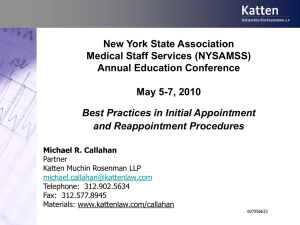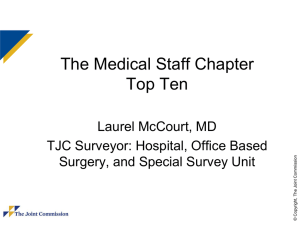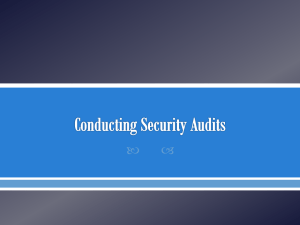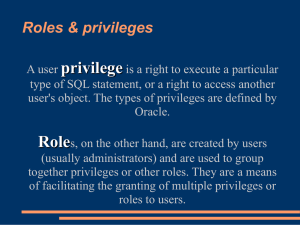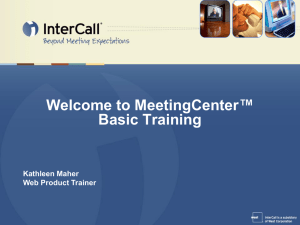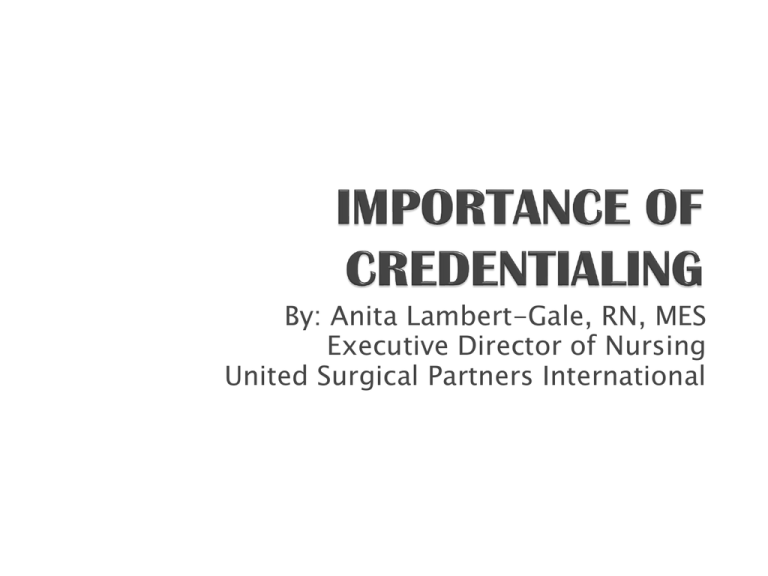
By: Anita Lambert-Gale, RN, MES
Executive Director of Nursing
United Surgical Partners International
Each participant will be able to:
Identify major requirements of regulatory
and accrediting bodies, for credentialing
Identify why credentialing is important
Identify five (5) significant red flags in
medical staff credentialing files
Leave with useful tools to facilitate the
credentialing and recredentialing process
Florida: Fingerprints all medical license renewals Discovered 2,000 out of 45,000 physicians have
criminal records
2001: nation’s medical boards took disciplinary
action against 2,708 physicians
DEA fails to report 2,592 docs to NPDB
Man poses as physician, spoke with and wrote a
prescription for an ER patient.
For 16 months, man posed as certified plastic
surgeon; operated without medical degree, clinical
training, license, or insurance. Today is on the run.
Man assumes identity of a psychiatrist and
practices for over 5 years.
Maryland doc sued 18 times in 20 years with 9
suits resulting in payments of more than $20
million; Board ignored provision of state law
that 3 or more claims in 5 years must be
reported.
2010 Surgeon at California hospital removed
a healthy kidney (wrong site).
The surgeon did not have privileges to
perform procedure.
Patient was non-English speaking
Patient latter underwent procedure to remove
the diseased kidney, leaving patient with no
kidney.
July 21, 2011 Gov. Pat Quinn signed into law
in Illinois House Bill 1271
◦ Law mandates “immediate and permanent
revocation” of licensure of healthcare professionals
convicted of sex crimes, felony or patient battery.
◦ Immediately 11 healthcare professionals lost
licensure
June 17, 2011 Gov. Rick Perry signed into law
revocation of the medical license of any
physician convicted of sexual assault or
indecency with a child.
September 16, 2011 “Fake Doc Pleads Guilty
in $1.2M Fraud Scheme”
◦ 30 year old worked with licensed physicians and
used their provider numbers to collect about $1.2
million in false claims with Medicare/Medicaid and
private insurance companies.
◦ Was caught while trying to sell patient health
information.
“Credentialing is complex and exhaustive
and requires a high degree of management
to assure the proper completion of
documentation and follow through with all
parties involved in the process.”
From Patrick Birmingham, head of EnrollMed
Operation of Medkinetics.com
To assure that only
qualified practitioners
who can demonstrate
current clinical
competence are granted
clinical privileges
Required by State and Regulatory Agencies,
i.e. State, TJC, AAAHC CMS, OIG
To assist in the risk management of the
Facility/Center
To “go the extra mile” to ensure those
providing the healthcare services to our
patients are competent and qualified.
Credentialing for appointment ensures the
physician has the training and education to
provide services.
Reappointment
ensures
the
physician
continues or increases knowledge base to
provide care.
Documented
Court Cases
1st case to hold that hospitals have a
corporate duty to monitor patient
care being provided in the facility.
Employees must observe condition of
patients and report findings to higher
authority if attending physician does
not do what is clearly proper.
Hospital found liable for negligent
treatment of patient by physician.
Negligence in reappointment; Negligent
credentialing.
Hospital liable for physician’s actions
due to its failure to request data from
other hospital about basis for its
summary suspension. No deficiencies
had occurred at Sharp Cabrillo.
Negligent Credentialing
Hospital liable for podiatrist’s negligence;
failed to obtain malpractice claims data;
although medical records department aware
of claims.
Court held that a hospital has a duty to
both select and review staff physicians
adequately.
Negligent credentialing; Failure of Initial
Credentialing Process
Hospital liable for patient injured by
physician who failed to disclose pending
malpractice cases and lied about privileges
at other hospitals; should have verified
information.
Court ruled the hospital had contributed to
the patient’s injury simply by allowing the
physician to have staff privileges.
Medical Staff Bylaws
Medical Staff Rules & Regulations
Credentialing Policies & Procedures
Very Important document.
Must be consistent with applicable licensing,
certifying and accrediting bodies.
Definitions
Purpose and Responsibilities
Medical Staff membership
Categories of the Medical Staff
Allied Health Professional
Medical Staff Clinical Privileges
Corrective Actions
Hearing and Appellate Review Procedures
Officers of the Medical Staff
Committees and Functions
Meetings
Confidentiality & Immunity from Liability
Amendments & Adoptions of Bylaws
Should be consistent with the Bylaws
Usually will embody the specific standards
and level of practice that are required of each
member
May be thought of as the Medical Staff’s
policies and procedures
Should carefully define the steps in the
credentialing and privileging process
Should be carefully followed, not to do so
places the facility at great risk
Issue to applicant cover letter, delineated
privilege list and a copy of the Medical Staff
Bylaws and Rules & Regulations
*Initial granting, verifies by viewing a valid
government issues photo ID issued by a state or
federal agency
Current licensure
Current DEA
Relevant Education/Training
Hospital Affiliations
Board Certification
Ability to Perform Requested Privileges
Malpractice Insurance (with applicable limits)
Malpractice Claims History
Query National Practitioner Data Bank
Criminal Background Check (per your Bylaws)
Peer References
Incomplete areas on the Application
Unexplained time gaps in training and/or practice
Positive responses regarding loss of privileges or
restrictions or loss of licensure/DEA registration
Frequent changes in location in a short period of
time
Pending/settled lawsuits - two fold issue
Non-responses from references
Cancellation notice from Malpractice carrier
received during or after process
Negative information from State Licensure
Association
Require that Clinical Privileges be granted by
the Governing Body
◦ Ensure that this is the language in your Medical
Staff Bylaws, Rules & Regulations, and any policies.
◦ Especially temporary privileges.
Review all clinical privileges in light of what
you actually do at your facility.
Delete any privileges on the that you do not
perform.
Add any additional privileges that you do in
your facility for that specific specialty
TJC requires NPDB with addition of
privileges.
DOPs MUST match facility’s approved
procedures list
Sedation by Non-anesthesiologist should be
specifically privileged
Medical Staff Leadership (MEC) must
determine criteria to be utilized for granting
Sedation privileges (Review community
standard)
Verify that the physician meets the criteria
Suggest privileges specify age groups for
procedures
Suggest privileges for EKG & radiology
interpretation, as appropriate
§416.42(c) “The ASC must specify the anesthesia
privileges for each practitioner who administers
anesthesia, or who supervise the administration
of anesthesia by another practitioner. The
privileges granted must be in accordance with
state law and the ASC’s policy. The type and
complexity of procedures for which the
practitioner may administer anesthesia or
supervise another practitioner supervising
anesthesia, must be specified in privileges
granted to the individual practitioner.”
§416.42(c) “when an ASC permits operating
physicians to supervising CRNA’s
administering anesthesia, the governing body
must adopt written policies that explicitly
provide for this.
Must make sure that all applicable boxes are
checked
Must have documented current competency
for the requested privileges
FORM TO REQUEST ADDITION OF A PROCEDURE TO THE
APPROVED PROCEDURE LIST.
Identify the Procedure:____________________
The usual age range for the patients
undergoing this procedure: ___________________
Additional Equipment Needed:_______________
Type of Anesthesia Required: ______________
Projected OR Time: ___ Projected PACU Time: _
Any other information that may assist the MAC
and BOG in their decision:_____________
Requesting Physician: _________ Date:________
If physician has ECFMG number, you must directly
query the ECFMG to verify. AMA Profile is NOT
primary source for ECFMG.
You may establish an account with ECFMG for on
line verification
Or ECFMG sends out monthly invoice to facility at
$25 per inquiry.
Each facility must have separate organization
number - if new, state new vendor and number will
be assigned to you on report.
ECFMG is primary source for foreign medical school
per Joint Commission.
What is it?
How do you do it?
What needs to be verified via Primary Source?
Utilize the AMA reappointment profile
Be sure to include information regarding
performance at the facility.
When a physician receives additional
education, he/she may apply for amended
privileges.
When the facility adds additional programs
which will require new privileges.
When the facility revises existing programs
and privileges are no longer
needed/utilized.
At time of reappointment.
Start with a complete application.
Follow the credentialing policies and
procedures
Use your checklist
Send out letters within 10 days of receipt
of application
Send follow-up letters within 30 days
Request the assistance of the practitioner if
you are having difficulty getting responses
National Practitioner Data Bank
State Licensing Board
DEA & if applicable State Specific
AMA Profiles (American Medical Association)
OIG Sanctions (Office of Inspector General)
GSA (Exclusions)
Criminal background
Some Healthcare System have on-line verification for
Medical Staff Membership and Privileges
Feel as though you’ve been
asked to pull a rabbit out of a
hat?
Telephone verifications
◦ complete appropriate telephone
verification form and sign/date
Fax verifications
◦ sign/date faxes received
Use Outlook to create tickler file
(reminders for
follow-up letters)
The reappointment process focuses on the
practitioner’s professional behavior and
competence while functioning at the
institution
Time frames vary, usually every two years
(refer to state regulations, TJC every 2 years,
AAAHC every 3 years)
Reappointment standard is surfacing as
one of the most problematic standards for
facilities - greater survey focus
Keys to Success - thorough
planning and follow through
Use the data base to review the
number of reappointments
scheduled to be processed
within a particular quarter and
plan your time accordingly
Take a proactive approach
Send reappointment materials to physicians 4-5
months prior to expiration of privileges
Send materials registered mail (Common
obstacle to timely reapplication completion is a
physician’s failure to return his or her
reappointment materials)
Follow-up with reminder letters or telephone
calls
Combating Delays, Cont.
Quality Data - (Internal information
gathered into
provider profile)
Volume, medical record completion and clinical
pertinence, risk management, results of peer review,
patient and staff complaints, aggregate performance
data, (medical assessment and treatment of patients,
blood, drug, operative/invasive procedures, UR,
departures from established patterns of clinical practice,
compliance with bylaws/rules and regs/policies, and
meeting attendance
Missed the deadline?
Inform LIP he/she would be required to cease providing care in
the facility until the reappointment process is completed
Medical Education, Internships,
Residencies and Fellowships - these
elements are considered static, and
therefore do not need to be reverified
Most states now have an online service
Follow up on any indication there is
something confidential or adverse
Read the material thoroughly!
Check web site for OIG or GSA sanctions at
appointment and reappointment.
If physician has been sanctioned and on
your staff and are seeing patients, you
could potentially lose reimbursement on
patients seen by physician.
www.exclusions.oig.hhs.gov/search.html
Statement that there is “no report” is what
you want to obtain
Suggestion - Have any adverse
information initialed by
Medical Director as evidence
that this was considered in the
appointment/ reappointment
process.
www.credentialinfo.com - major site for
credentialing information - also provide free
weekly newsletter via e-mail; sign up at web
site
www.namss.org - National Association of
Medical Staff Services
Must be provided for within your Bylaws
Must follow your Bylaws
For important
patient needs:
Current
licensure
◦ Current
competence
Both of these can
be accomplished by
a phone call.
New Applicants
◦ Current licensure
◦ Relevant education training or experience
◦ Current competency
◦ Ability to perform the privileges requested
◦ NPDB
◦ Criteria identified in the bylaws, rules &
regs
New applicants must have the following
◦ A complete application
◦ No current or previously successful challenge to
licensure or registration
◦ Not been subject to involuntary limitation,
reduction, denial, or loss of privileges, when
applicable to discipline
Joint Commission
states the
“Administrator or
designee grants
temporary privileges
for meeting
important patient
needs and for new
applicants upon the
recommendation of
clinical leadership or
the medical
director.”
When an applicant with a complete, clean
application is waiting for review by the MEC
and Governing Body:
◦ Must have verified current licensure,
relevant training or experience, current
competence, ability to perform privileges
requested
◦ Must have queried NPDB
and evaluated report
Temporary Privileges
When an applicant has a complete
application:
◦ No current or previously successful
challenge to licensure or registration
◦ Not been subject to involuntary
termination of medical staff membership
at another organization
◦ Not been subject to involuntary
limitation, reduction, denial or loss of
clinical privileges.
LIP fails to provide
necessary
information in a
timely manner.
Facility fails to
verify necessary
information in a
timely manner.
Any time a physician surrenders his privileges
(temporary or not) while under investigation,
this is reportable to the NPDB. Grant
temporary privileges before joining staff,
start an investigation and temporary
privileges have to be revoked, withdrawn, etc,
and become reportable to the data bank.
Joint Commission defines as any organization
that provides information on an individual’s
professional credentials.
Further the organization should have
confidence in the completeness, accuracy,
and timeliness of the information
Joint Commission identifies 10 principles to
guide a CVO organization.
1. Makes known to the user the data and
information it can provide.
2. Provides documentation to the user
describing how its data collection,
information development, and verification
process(es) are performed.
3. Provides sufficient, clear information on
database functions, including any limitations
of information available from the agency
(such as practitioners not included in the
database), the time frame for agency
responses to requests for information, and a
summary overview of quality control
processes related to data integrity, security,
transmission accuracy, and technical
specifications.
4.
5.
6.
Both agree on the format for transmitting
information about an individual.
User can easily discern what information
transmitted by the CVO is from primary
source and what is not.
For information transmitted by the agency
that can go out of date, the CVO provides
the date information was last updated from
the primary source.
7.
8.
CVO certifies that the information
transmitted to the user accurately represents
the information obtained by it.
User can discern whether the information
transmitted by the CVO from a primary
source is all primary source information in
the CVO’s possession pertinent to a given
item or, if not, where additional information
can be obtained.
9.
10.
User can engage the CVO’s quality control
processes when necessary to resolve
concerns about transmission errors,
inconsistencies, or other data issues that
may be identified.
User has a formal arrangement with the
CVO for communicating changes in
credentialing information.
“An accreditable organization may use
information provided by a CVO after proper
assessment of the capabilities and quality of
the CVO…a CVO may demonstrate such
capability and quality by becoming accredited
or certified by a nationally recognized
accreditation organization. Primary or
secondary source verification is required for
items listed
9In manual), unless a CVO or an organization
performing primary source verification that is
accredited or certified by a nationally
recognized body is used. If the organization
utilizes a CVO or another organization to
verify credentials, those entities must
perform primary source verification unless
such sources do not exist or are impossible
to verify.”
Tops the of list of problematic standards
from virtually all accrediting bodies
Anita Lambert-Gale
USPI
Creekside Crossing III
8 Cadillac Drive
Suite 200
Brentwood, TN 37027
anlambert@uspi.com
(615) 376-7522


